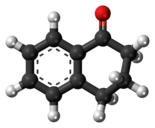1-Tetralone
 |
|
 |
|
| Names | |
|---|---|
|
IUPAC name
3,4-Dihydro-2H-naphthalen-1-one
|
|
| Other names
α-Tetralone; 1-Tetralone
|
|
| Identifiers | |
|
3D model (JSmol)
|
|
| ChemSpider | |
| ECHA InfoCard | 100.007.692 |
|
PubChem CID
|
|
|
|
|
|
| Properties | |
| C10H10O | |
| Molar mass | 146.19 g·mol−1 |
| Density | 1.099 g/mL |
| Melting point | 2 to 7 °C (36 to 45 °F; 275 to 280 K) |
| Boiling point | 113 to 116 (6 mmHg) |
|
Except where otherwise noted, data are given for materials in their standard state (at 25 °C [77 °F], 100 kPa).
|
|
|
|
|
| Infobox references | |
1-Tetralone is an organic chemical compound with the molecular formula C10H10O. It is a common intermediate in organic synthesis. It is a ketone derivative of tetralin, a hydrogenated derivative of naphthalene. A related compound is 2-tetralone.
1-Tetralone can be prepared by several methods. A typical methods involve intramolecular cyclisation of phenylbutyric acid.
The Haworth reaction is a classic method for the synthesis of tetralone.Benzene is reacted with succinic anhydride by a Friedel–Crafts acylation, the intermediate product is reduced and a second Friedel–Crafts acylation takes place upon the addition of acid.
1-Tetralone is a precursor to 1-naphthol by dehydrogenation:
...
Wikipedia
